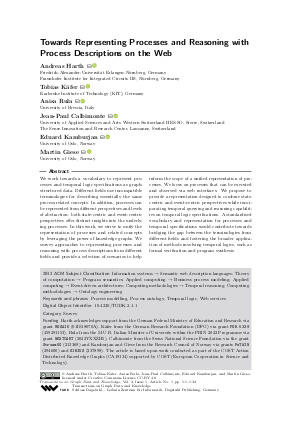TGDK.2.1.1.pdf
- Filesize: 0.87 MB
- 32 pages

 Creative Commons Attribution 4.0 International license
Creative Commons Attribution 4.0 International license

We work towards a vocabulary to represent processes and temporal logic specifications as graph-structured data. Different fields use incompatible terminologies for describing essentially the same process-related concepts. In addition, processes can be represented from different perspectives and levels of abstraction: both state-centric and event-centric perspectives offer distinct insights into the underlying processes. In this work, we strive to unify the representation of processes and related concepts by leveraging the power of knowledge graphs. We survey approaches to representing processes and reasoning with process descriptions from different fields and provide a selection of scenarios to help inform the scope of a unified representation of processes. We focus on processes that can be executed and observed via web interfaces. We propose to provide a representation designed to combine state-centric and event-centric perspectives while incorporating temporal querying and reasoning capabilities on temporal logic specifications. A standardised vocabulary and representation for processes and temporal specifications would contribute towards bridging the gap between the terminologies from different fields and fostering the broader application of methods involving temporal logics, such as formal verification and program synthesis.







Feedback for Dagstuhl Publishing